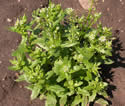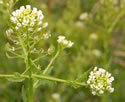Thlaspi arvense (Field Pennycress)
| Also known as: | |
|---|---|
| Genus: | Thlaspi |
| Family: | Brassicaceae (Mustard) |
| Life cycle: | annual |
| Origin: | Europe |
| Status: |
|
| Habitat: | sun; roadsides, waste areas, fields, disturbed soil |
| Bloom season: | April - June |
| Plant height: | 4 to 20 inches |
| Wetland Indicator Status: | GP: FACU MW: FACU NCNE: UPL |
| MN county distribution (click map to enlarge): |  |
| National distribution (click map to enlarge): |  |
Pick an image for a larger view. See the glossary for icon descriptions.
Detailed Information
Flower: 

![[photo of flowers]](/udata/r9ndp23q/white/pennycress_0514_114413-t.jpg) Elongating clusters of stalked flowers at the top of the plant and at the tips of branching stems arising from the upper leaf axils, with a densely packed, rounded cluster of open flowers at the tip and fruit forming below. Upper branches are often initially horizontal, becoming ascending. Individual flowers are white, about ¼ inch across, with 4 oval petals and 6 yellowish green stamens, 3 on each side of the flat ovary. The 4 green sepals behind the flower have whitish edges.
Elongating clusters of stalked flowers at the top of the plant and at the tips of branching stems arising from the upper leaf axils, with a densely packed, rounded cluster of open flowers at the tip and fruit forming below. Upper branches are often initially horizontal, becoming ascending. Individual flowers are white, about ¼ inch across, with 4 oval petals and 6 yellowish green stamens, 3 on each side of the flat ovary. The 4 green sepals behind the flower have whitish edges.
Leaves and stem: 


![[photo of leaves]](/udata/r9ndp23q/white/pennycress_0520_181930-t.jpg) There is a rosette of spatula shaped basal leaves that wilt away early. Stem leaves are 1 to 4 inches long and up to 1 inch wide, hairless, with irregular blunt teeth and a rounded or blunt point at the tip. The edges are often a little wavy. Leaves near the base of the plant may have short stems; those nearer the top are more clasping. Attachment is alternate. Stems are ribbed, hairless, and branched in the upper plant.
There is a rosette of spatula shaped basal leaves that wilt away early. Stem leaves are 1 to 4 inches long and up to 1 inch wide, hairless, with irregular blunt teeth and a rounded or blunt point at the tip. The edges are often a little wavy. Leaves near the base of the plant may have short stems; those nearer the top are more clasping. Attachment is alternate. Stems are ribbed, hairless, and branched in the upper plant.
Fruit: 
![[photo of fruit]](/udata/r9ndp23q/white/pennycress_0524_133408-t.jpg) Fruit is a flat oval pod about ½ inch long with a notch at the tip. It dries to a papery brown shell. Each side of the pod holds up to 8 seeds.
Fruit is a flat oval pod about ½ inch long with a notch at the tip. It dries to a papery brown shell. Each side of the pod holds up to 8 seeds.
Notes:
The flowers of Field Pennycress are not very distinctive, but the seedpods are and make this plant easy to identify.
Native Plant Nurseries, Restoration and Landscaping Services ↓
More photos
 Field Pennycress plant
Field Pennycress plant Field Pennycress plant
Field Pennycress plant Field Pennycress plants
Field Pennycress plants horizontal side branches
horizontal side branches fruit turns yellowish then light brown
fruit turns yellowish then light brown more flowers
more flowers more flowers
more flowers
Photos by K. Chayka taken in Ramsey County. Other photos courtesy Peter M. Dziuk.
Comments
Have you seen this plant in Minnesota, or have any other comments about it?
on: 2016-04-30 11:00:16
I have this growing in one of my small gardens. The way it came up was like it was specifically planted there. I let it grow because it kind of looked like the annual I planted last year. Do I leave it grow or pull it out?
on: 2016-04-30 12:34:59
Crista, it's a weed, though not a terribly aggressive one. I don't think it has much value to wildlife and I don't personally find it that attractive, though the seed heads are kind of interesting. Use your best judgement.
on: 2021-05-18 19:06:20
Our entire neighborhood suddenly became covered in this invader this year. They are mostly growing where the blasted construction vehicles were out on a city project. I'm really sick of careless construction people refusing to clean their vehicles. These things barely sprouted a month ago and they're already seeding.
on: 2021-05-19 19:08:15
Well, if there's any "good" news about pennycress, the sees are supposed to be edible - meaning easily killed. I ate a few raw. So far they haven't given me acute poisoning or an allergy. Next I find out how my stomach likes a handful on salad. They taste sharp and peppery, but not nearly as hot as black pepper.
on: 2021-06-27 20:32:45
OK, the seeds gave me indigestion.
on: 2022-01-11 09:04:37
Hello, The seed heads are becoming prized by florists. I'm a flower farmer and have not been able to find any seed. Would anyone be wiling to send me an envelope of seed? Thanks in advance, Christine
on: 2022-01-11 10:36:20
Christine, the Minnesota Wildflowers website is not the proper forum for soliciting plant or seed exchanges. We also strongly oppose the propagation of non-native weeds for any reason, no matter how benign you might think it is.
on: 2022-04-07 11:22:33
There is current research in cultivating this a oilseed cash crop. While I'm not condoning cultivating an invasive species, USDA states it is naturalized in every state of the continental US...so the damage has been done. It poses serious risk to cattle.
on: 2022-11-01 09:41:11
It's one of the proposed winter oilseed crops. It could provide vegetative cover on millions of acres of land that is now bare for 8-9 months of the year. So it would create a marketable crop while drastically reducing erosion and runoff of pollutants and nutrients, thus improving water quality of rivers and lakes.






